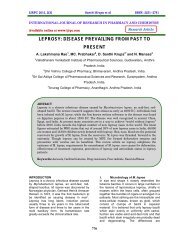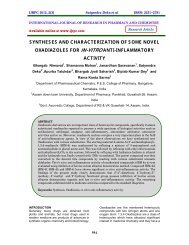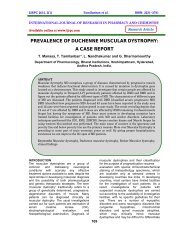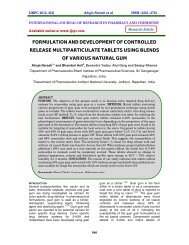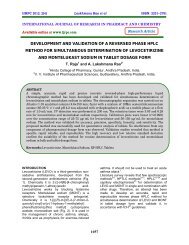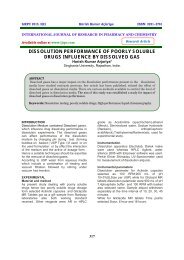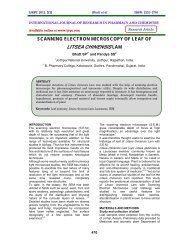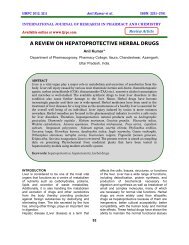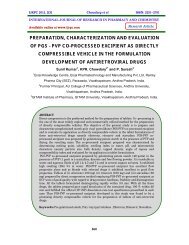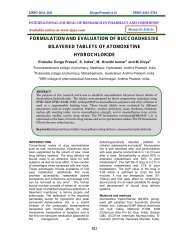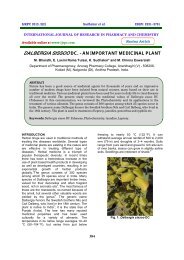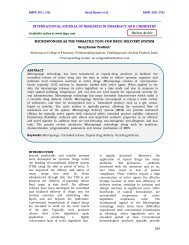LIPOSOME AS A DRUG CARRIER – A REVIEW - ijrpc
LIPOSOME AS A DRUG CARRIER – A REVIEW - ijrpc
LIPOSOME AS A DRUG CARRIER – A REVIEW - ijrpc
Create successful ePaper yourself
Turn your PDF publications into a flip-book with our unique Google optimized e-Paper software.
IJRPC 2013, 3(1) Loveleenpreet Kaur et al ISSN: 22312781<br />
INTERNATIONAL JOURNAL OF RESEARCH IN PHARMACY AND CHEMISTRY<br />
Available online at www.<strong>ijrpc</strong>.com<br />
Review Article<br />
<strong>LIPOSOME</strong> <strong>AS</strong> A <strong>DRUG</strong> <strong>CARRIER</strong> <strong>–</strong> A <strong>REVIEW</strong><br />
Loveleenpreet Kaur 1 *, Prabhjot Kaur and MU. Khan<br />
Department of pharmaceutics, Sri Sai College of Pharmacy, Badhani, Pathankot, Punjab,<br />
Chandigarh, India.<br />
ABSTRACT<br />
Liposome is acceptable and superior carrier and has ability to encapsulate hydrophilic and<br />
lipophilic drugs and protect them from degradation. Liposomes are vesicles having concentric<br />
phospholipids bilayer molecules from low molecular weight to higher molecular weight have<br />
been incorporated in liposomes.The water soluble compounds/drugs are present in aqueous<br />
compartments while lipid soluble compound/drugs and amphiphilic compounds/ drugs insert<br />
themselves in phospholipids bilayers. Liposome containing drugs can be administrated by<br />
many Abstract: routes (intervenous, oral, inhalation, local application, ocular) and these can be used for<br />
treatment of various diseases. Liposomes are biocompatible, completely biodegradable, nontoxic,<br />
and non-immunogenic. Liposomes are prepared by using various methods hydration,<br />
ethanol injection method, ether injection method, Sonication method, micro-emulsion method.<br />
The different application of liposomes is use for treatment of infection, anti-cancer, vaccination,<br />
for human therapy and gene delivery system. After the formulation, the evaluation of liposomes<br />
are checked by using physical parameters, chemical parameters, and biologically for the<br />
establish the purity and potency of various lipophilic constituents and establish the safety and<br />
suitability of formulation for therapeutic application.<br />
Keywords: Liposome, lipophilic drugs, phospholipids, biodegradable.<br />
1.1 INTRODUCTION 1-14<br />
Liposomes vesicles were prepared in the early<br />
years of their history from various lipid<br />
classes identical to those present in most<br />
biological membranes. liposomes were<br />
discovered in the mid of 1960’s and originally<br />
studied as cell membrane model Paul Ehrlich<br />
coined the term “magic bullet” in 20 th century<br />
where carrier system was proposed to simply<br />
carry the drug to its of action and releasing its<br />
selectively while non <strong>–</strong> target sits should<br />
absolutely be example from drug effect.<br />
Liposomes are vesicles having concentric<br />
phospholipids bilayer molecules from low<br />
molecular weight to high molecular weight<br />
have been incorporated in liposomes.The<br />
water soluble compounds/drugs are present in<br />
aqueous compartments while lipid soluble<br />
compound/drugs and amphilhilic<br />
compounds/drugs insert themselves in<br />
phospholipids bilayer. The liposomes<br />
containing drugs can be administrated by<br />
many routes (intervenous, oral inhalation, local<br />
application, ocular) and these can be used for<br />
the treatment of various diseases.<br />
Multilamellar liposomes (MLV) usually range<br />
from 500 to 10, 000 nm. Unilamellar liposomes<br />
can be called as small (SUL) and as large<br />
(LUV): SUV are usually smaller than 50nm<br />
and LUVare usually large than 50nm. The<br />
liposomes of very large size are called gaint<br />
liposomes (10,000-10, 00, 00 nm). They can<br />
be either unilamellar or multilamellar. The<br />
liposomes containing encapsulated vesicles<br />
are called multi-vesicle liposomes. Their size<br />
range from 2,000-40,000 nm. LUVs having<br />
asymmetric distribution of phospholipids in the<br />
bilayer are called asymmetric liposomes .<br />
The delivery of drugs onto the skin is<br />
recognized as an effective means of therapy<br />
for local dermatologic diseases 4 .Liposome is<br />
acceptable and superior carrier and has ability<br />
to encapsulate hydrophilic and lipophilic drugs<br />
and protect them from degradation.<br />
Topical drug administration is a localized drug<br />
delivery system anywhere in the body<br />
through ophthalmic, rectal, vaginal and skin as<br />
topical routs. Skin is one of the most readily<br />
accessible organs on human body for topical<br />
administration and is main route of topical drug<br />
121
IJRPC 2013, 3(1) Loveleenpreet Kaur et al ISSN: 22312781<br />
delivery system 4,5,6 .Topical application of<br />
liposome vesicles has many advantages over<br />
the conventional dosage forms.<br />
In general, they are deemed more effective<br />
and less toxic than conventional<br />
formulations due to the bilayer composition<br />
and structure. . liposomes are usually applied<br />
to the skin as liquids or gels. For topical<br />
application of liposomes in gel form,<br />
hydrophilic polymers are considered to be<br />
suitable thickening agents. Liposome<br />
carriers, well known for their potential in topical<br />
drug delivery, have been chosen to help<br />
transport drug molecules in the skin layers.<br />
These vesicles are also expected to provide<br />
lipid enriched hydrating conditions to help<br />
retain the drug molecules with in the dermal<br />
layers, at or near to the site of action. Stability<br />
of the liposomes in terms of their drug holding<br />
capacity was assessed for a period of 5<br />
weeks, on storage under defined conditions.<br />
The delivery of drugs onto the skin is<br />
recognized as an effective means of therapy<br />
for local dermatologic diseases<br />
Liposomes are formed open hydration of lipid<br />
molecules normally lipids are hydrated from<br />
a dry state(thin or thick lipid film, spray dried<br />
powder),and stacks of crystalline bilayer<br />
become fluid and swell myelin-long, thin<br />
cylinders grow and upon agitation detach self<br />
close in to large, multilameller liposomes<br />
because this eliminates, unfavorable<br />
interactions at the edges.<br />
Once the large particles are formed they can<br />
be either broken by mechanical treatment in to<br />
smaller bilayered fragments, which close into<br />
smaller liposomes .The size of liposomes in<br />
the budding off mechanism is very difficult to<br />
caluculate, in the self closing bilayer<br />
mechanism the liposomes size depends, the<br />
bending elasticity of the bilayer and the edges<br />
interaction of open fragments. These factors<br />
determine the size of the vesicle size.<br />
Liposomes have been reported to be effective<br />
drug carriers. Local anesthetics encapsulated<br />
into liposomes show longer duration of action,<br />
reduction in circulating plasma levels, reduced<br />
central nervous system toxicity, and reduced<br />
cardiovascular toxicity.<br />
Liposomes are single or multilayered vesicles<br />
that completely enclose an aqueous phase<br />
within one or several phospholipids bilayer<br />
membrane. An important aspect of liposomes<br />
is the protection that they afford as an<br />
encapsulating agent against potentially<br />
damaging conditions in external environments.<br />
Liposomes are also a system in their own right<br />
in medical, cosmetic, and industrial<br />
application.<br />
However major limitation of using liposomes<br />
topically is the liquid nature of preparation.<br />
They can be overcome by their incorporation<br />
in adequate vehicles where original structure<br />
of vesicles is preserved. It has already been<br />
shown that liposomes are fairly compatible<br />
with gels made from polymers derived from<br />
cross linked polyacrylic acid, such as carbopol<br />
resins.<br />
1.2 Classification of liposomes 15<br />
Liposome vesicles were prepared in the early<br />
years of their history from various lipid classes<br />
identical to those present in most biological<br />
membranes. Basic studies on liposomes<br />
vesicles resulted in numerous methods of their<br />
preparation and characterization. Liposomes<br />
are broadly defined as lipid bilayer surrounding<br />
an aqueous space. Multilamellar vesicles<br />
(MLV) consist of several (up to 14) lipid layers<br />
(in an onion-like arrangment) separated<br />
nanometers in diameter. Small unilamellar<br />
vesicles (SUV) are surrounded by a single lipid<br />
layer and are 25-50nm.<br />
Based on structural parameters<br />
Small unilamellar vesicles (SUV):<br />
Size range from 20-40nm.<br />
Medium unilamellar vesicles (MUV):<br />
Size range from 40-80nm.<br />
Large unilamellar vesicles (LUV):<br />
Size range from 100-1000nm.<br />
Oligolamellar vesicles (OLV)<br />
These are made up of 2-10 bilayers<br />
of lipids surrounding a large internal<br />
volume.<br />
<br />
Multilamellar vesicles (MLU)<br />
They have several bilayers. They can<br />
compartmentalize the aqueous<br />
volume in an infinite numbers of ways.<br />
They differ according to way by which<br />
they are prepared. The arrangements<br />
can be onion like arrangements of<br />
concentric spherical bilayer of<br />
LUV/MLV enclosing a large number of<br />
SUVs.<br />
Based on Method of liposome<br />
preparation<br />
REV: single or oligolamellar vesicles<br />
made by Reverse-Phase Evaporation<br />
Method.MLV-REV: Multilamellar<br />
vesicles made by Reverse-Phase<br />
Evaporation Method.<br />
SPLV: Stable Plurilamellar vesicles.<br />
FATMLV: Frozen and Thawed MLV.<br />
VET: Vesicles repaired by extrusion<br />
technique.<br />
DRV: Dehydration-rehydration<br />
Method.<br />
Based upon composition and<br />
Application:<br />
122
IJRPC 2013, 3(1) Loveleenpreet Kaur et al ISSN: 22312781<br />
Conventional liposomes (CL): Neutral<br />
or negatively charged phospholipids<br />
and Chol.<br />
Fig. 1:<br />
1.3 Advantages of liposomes 16<br />
Liposomes are biocompatible,<br />
completely biodegradable, nontoxic<br />
and non-immunogenic.<br />
Liposomes are suitable for<br />
delivery of hydrophobic,<br />
amphiphatic and hydrophilic<br />
drugs.<br />
<br />
Liposomes are protecting the<br />
encapsulated drug from the<br />
external environment.<br />
Liposomes are reduced the<br />
toxicity and increased the<br />
theraputical effect of the drugs.<br />
<br />
They are increase the activity of<br />
chemotherapeutic drugs and can<br />
improved through liposome<br />
encapsulation this reduce<br />
deleterious effect that are<br />
observed at concentration similar<br />
to or lower than those required<br />
for maximum therapeutic activity.<br />
They reduce exposure of<br />
sensitive tissues to toxic drugs.<br />
1.4 Disadvantages of liposomes<br />
Production cost is high.<br />
Leakage and fusion of<br />
encapsulated drug/molecules.<br />
Short half-life.<br />
Stability problem.<br />
.<br />
2.1 Methods of Preparation of<br />
liposomes<br />
Hydration method.<br />
Ethanol injection method.<br />
Ether injection method.<br />
Sonication method.<br />
Micro-emulsification method.<br />
2.2 Hydration method 17<br />
This is simplest and widely used method.<br />
The Lipid mixture and<br />
charged components are dissolved in<br />
chloroform, Methanol mixture and then<br />
this mixture is introduced in to a 250 ml<br />
Round bottomed flask. The flask is<br />
attached to rotary evaporator connected<br />
with vacuum pump and rotated at 60 rpm.<br />
The organic solvents are evaporated at<br />
about 30°.Adry lipid residue is formed at<br />
the walls of the flask and rotation is<br />
continued for 15 minutes after dry lipid<br />
residue appeared. The evaporator is<br />
detached from vacuum pump and<br />
nitrogen is introduced into it. The flask is<br />
then removed from evaporator and fixed<br />
onto lyophilized to remove residual<br />
solvent. Then the flask is again flushed<br />
with nitrogen and 5 ml of phosphate<br />
buffer is added .The flask is attached to<br />
evaporator again and rotated at 60 rpm<br />
speed for 30 minutes or until all lipid has<br />
been removed from the wall of the flask.<br />
A milky white suspension is formed<br />
finally. The suspension is allowed to<br />
stand for 2 hours in order to complete<br />
swelling process to give MLVs.<br />
2.2 Ethanol injection method 8<br />
This is simple method. In this method an<br />
ethanol solution of the lipids is directly<br />
inject rapidly to an excess of saline or<br />
other aqueous medium through a fine<br />
needle. The ethanol is diluted in water<br />
and phospholipids molecules are<br />
dispersed evenly through the medium.<br />
The procedure yields a high proportion of<br />
SUVs.<br />
123
IJRPC 2013, 3(1) Loveleenpreet Kaur et al ISSN: 22312781<br />
2.3 Ether injection 8<br />
The method is similar to above one. It<br />
involves injecting the immiscible organic<br />
solution very slowly into an aqueous<br />
phase through a narrow needle at<br />
temperature of vaporizing of organic<br />
solvent. In this method the lipids are<br />
carefully treated and there is very less<br />
risk of oxidative degradation.<br />
2.4 Sonication 11<br />
This method reduces the size of the<br />
vesicles and impart Energy to lipid<br />
suspension .This can be achieved by<br />
exposing the MLV to ultrasonic<br />
irradiation. There are two methods of<br />
Sonication.<br />
(a) Using bath sonicator.<br />
(b) Using probe sonicator.<br />
Fig. 3:<br />
The probe Sonication is used for<br />
suspension which requires high<br />
energy in small volume. The bath<br />
sonicator is used for large volume of<br />
dilute lipids. The disadvantage of probe<br />
sonicator is contamination of preparation<br />
with metal from tip of probe. By this<br />
method small unilamellar vesicles are<br />
formed and they are purified by<br />
ultracentrifugation.<br />
2.5 Micro-emulsification method 11<br />
Equipment called micro- fluidizer is used<br />
to prepare small vesicles from<br />
concentrated lipid suspension. The lipids<br />
can be introduced in to the fluidizer as a<br />
suspension of large MLVs. The<br />
equipment pumps the fluid at very high<br />
pressure through 5 micrometer screen.<br />
Then it is forced long micro channels,<br />
which dried two streams of fluids collide<br />
together at right angles at very high<br />
velocity. The fluid collected can be<br />
recycled through the pump and<br />
interaction chamber until vesicles of<br />
spherical dimensions are o<br />
btained .<br />
3.1 Application of liposomes 12-13<br />
Liposomes were developed as an<br />
advanced drug delivery vehicle. They are<br />
generally considered non-toxic,<br />
biodegradable and non-immunogenic.<br />
Associating a drug with liposomes<br />
markedly changes its pharmacokinetics<br />
and lowers systemic toxicit, furthermore,<br />
the drug is prevented from early<br />
degradation and/or inactivation after<br />
introduction to the target organism.<br />
Liposomes in infection treatment<br />
Liposomes are useful in the treatment of<br />
parasitic infections of the MPS, such as<br />
leishmaniasis. Encapsulating the<br />
amphotericin B into liposomes reduces<br />
the renal and general toxicity, and the<br />
therapeutic efficiency is improved. The<br />
encapsulation of the anti-tuberculosis<br />
drug Rifampicin or Isoniazid in liposomes<br />
targeted to lung improves the efficacy of<br />
the drug.<br />
Liposomes as vaccine system<br />
Liposomes can be used as enhancers of<br />
the immunological response by<br />
incorporation of antigens 61. For this<br />
purpose the liposomes are administered<br />
intramuscularly, a location where the<br />
encapsulated antigen is released slowly<br />
and accumulate passively within regional<br />
lymph nodes. To control the antigen<br />
release and improve the antibody<br />
response, the liposomes encapsulating<br />
antigens are subsequently encapsulated<br />
into alginate lysine microcapsules.<br />
Hepatitis A virus incorporated into<br />
liposomes proved to be a suitable<br />
formulation in term of rapid<br />
seroconversion high level of mean<br />
antibody content and low reactogenicity.<br />
Also, there is in clinical trial vaccines<br />
against influenza, Hepatitis B, diphtheria,<br />
tetanus, E-coli infection .<br />
Liposomes in human therapy<br />
Despite of the good and encouraging<br />
results obtained using liposomes as<br />
vehicles for drugs in numerous diseased<br />
animal models, in human therapy; the use<br />
of liposomes is restricted to systemic<br />
fungal infections and cancer therapy,<br />
only. However, liposomes based vaccines<br />
show great promise and vaccine against<br />
hepatitis A is already on the market.<br />
124
IJRPC 2013, 3(1) Loveleenpreet Kaur et al ISSN: 22312781<br />
Liposomes in anticancer therapy<br />
Based on the early studies that showed<br />
that encapsulation of a drug inside of<br />
liposomes reduces its toxic side effects,<br />
the liposomes were considered as<br />
attractive candidates for the delivery of<br />
anticancer agents. Intravenously<br />
administered stealth liposomes were<br />
passive targeted to solid tumors due to<br />
their extravasations in leaky blood<br />
vessels supporting the tumor. The good<br />
result obtained with Liposomal<br />
encapsulation Doxorubicin and<br />
Daunorubicin have lead to two products<br />
licensed for use in the treatment of<br />
Kaposi’ sarcoma, namely Doxil and<br />
Daunoxome.<br />
Liposomes in Gene delivery<br />
Gene therapy is the process which DNA<br />
delivers sequences encoding specific<br />
altered genes to cells with the goal of<br />
treating or curing genetic diseases. Thus,<br />
instead of treating the symptoms of the<br />
diseases as in conventional medicines,<br />
gene therapy has the potential to correct<br />
the underlying cause of genetic diseases.<br />
While the idea of gene therapy is a simple<br />
concept, the delivery of genes to the<br />
diseased areas turned out to be a difficult<br />
task. The problems associated with the<br />
use of viral vectors for gene therapy, lead<br />
to the search for less- hazardous, nonviral<br />
delivery systems. As an alternative<br />
to viral vectors, cationic liposomes have<br />
been developed for gene transfer since<br />
they have no limit for the size of the gene<br />
to be delivered and exhibit low<br />
immunogenicity.<br />
4.1 Evaluation of liposomes 14<br />
Liposomal formulation and processing for<br />
specified purpose are characterized to<br />
ensure their predictable in-vitro and invivo<br />
performance. The characterization<br />
parameters for purpose of evaluation<br />
could be classified into 3 broad<br />
categories which include physical,<br />
chemical, and biological parameters.<br />
Physical characterization<br />
evaluates various parameters<br />
including size, shape, surface<br />
features, lamellarty, phase<br />
behaviors and drug release<br />
profile.<br />
Ma etal. Evaluated structural<br />
integrity of Liposomal<br />
phospholipids membrane by a<br />
new technique of gamma-ray<br />
perturb angular correlation (PAC)<br />
spectroscopy .In this 111 In label<br />
diethylene triamine penta acetic<br />
acid (DTPA)<br />
Derivative<br />
dipalmitiyl<br />
phosphatidyl ethanoamine<br />
(DPPE) lipid were incorporated in<br />
the SUVs.<br />
This helped in the continuous<br />
non-invasive monitoring of the<br />
microenvironment of the lipid<br />
bilayer.<br />
Chemical Characterization<br />
includes those studies which<br />
establish the purity and potency<br />
of various lipophilic constituents.<br />
Biological Characterization<br />
parameters are helpful in<br />
establishing the safety and<br />
suitability of formulation for<br />
therapeutic application.<br />
4.2 Vesicle shape and Lamellarity<br />
Vesicle shape can be assessed<br />
using Electron Microscopic<br />
Techniques. Lamellarity of<br />
vesicles i.e. number of bilayer<br />
present in liposomes is<br />
determined using Freeze-<br />
Fracture Electron Microscopy and<br />
P-31 Nuclear Magnetic<br />
Resosance Analysis.<br />
4.3 Vesicle size and size<br />
distribution 15-19<br />
Various techniques are described<br />
in literature for determination of<br />
size and size distribution. These<br />
include Light Microscopy,<br />
Electron Microscopy (especially<br />
Transmission<br />
Electron<br />
Microscopy), Laser light<br />
scattering Photon correlation<br />
Spectroscopy, Field Flow<br />
Fractionation, Gel permeation<br />
and Gel Exclusion. The most<br />
precise method of determine size<br />
of liposome is Electron<br />
Microscopy Since it permit one to<br />
view each individual liposome<br />
and obtain exact information<br />
about profile of liposome<br />
population over the whole range<br />
of sizes. Unfortunately, it is very<br />
time consuming and require<br />
equipments that may not always<br />
be immediately to hand. In<br />
contrast, laser light scattering<br />
method is very simple and rapid<br />
to perform but having<br />
disadvantage of measuring an<br />
125
IJRPC 2013, 3(1) Loveleenpreet Kaur et al ISSN: 22312781<br />
average property of bulk of<br />
liposomes. Another more recently<br />
developed microscopic technique<br />
known as atomic force<br />
microscopy has been utilized to<br />
study liposome morphology, size,<br />
and stability.<br />
Most of methods used in size, shape<br />
and distribution analysis can be<br />
grouped into various categories<br />
namely microscopic, diffraction,<br />
Scattering, and hydrodynamic<br />
techniques.<br />
Biological Characterization 20<br />
Characterization<br />
parameters<br />
Instrument for Analysis<br />
Sterility<br />
Aerobic/Anaerobic Culture<br />
Pyrogenicity<br />
Rabbit Fever Response<br />
Animal toxicity<br />
Monitoring Survival Rats.<br />
Physical Characterization 21-26<br />
Characterization Parameters<br />
Instrument for analysis<br />
Vesicle shape and surface morphology<br />
TEM and SEM<br />
Vesicle size and Size distribution<br />
Dynamic light scattering TEM<br />
Surface Charge<br />
Free flow electrophoresis<br />
Electrical surface potential and surface pH<br />
Zeta potential measurement and pH<br />
sensitive probes.<br />
Lamellarity<br />
p 31 NMR<br />
Phase behavior<br />
DSC , freeze fracture electron<br />
microscopy<br />
Percent Capture<br />
Mini column centrifugation<br />
Drug release<br />
Diffusion cell/ dialysis<br />
Chemical Characterization 27-28<br />
Characterization<br />
parameters<br />
Instrument for analysis<br />
Phospholipids concentration HPLC/Barrlet assay<br />
Cholesterol concentration HPLC/Cholesterol oxide assay<br />
Phospholipids per oxidation<br />
U.V observation<br />
pH<br />
pH Meter<br />
Osmolarity<br />
osmometer<br />
4.4 Stabilization of liposome 29-35<br />
The stability of liposome should meet the<br />
same standard as conventional<br />
pharmaceutical formulation. The stability<br />
of any pharmaceutical product is the<br />
capabilities of the delivery system in the<br />
prescribed formulation to remain within<br />
defined or pre-established limits for<br />
predetermined period of time.<br />
Chemical Stability involves<br />
prevention of both the hydrolysis<br />
of ester bonds in the<br />
phospholipids bilayer and the<br />
oxidation of unsaturated sites in<br />
the lipid chain.<br />
Chemical instability leads to<br />
physical instability or leakage of<br />
encapsulated drug from the<br />
bilayers and fusion and finally<br />
<br />
aggregation of vesicles.<br />
Chen etal. Introduced the proliposome<br />
concept of liposome<br />
preparation to avoid<br />
physicochemical instability<br />
<br />
encountered in liposome<br />
suspension such as<br />
aggregation, fusion, hydrolysis<br />
and / or oxidation.<br />
Approaches that can be taken to<br />
increase Liposomal stability<br />
involve efficient formulation and<br />
lyophilization. Formulation<br />
involves the selection of the<br />
appropriate lipid composition,<br />
concentration of bilayers,<br />
aqueous phase ingredients such<br />
as buffers, antioxidant, metal<br />
chelators and cryo protectants.<br />
Charge inducing lipids such as<br />
phosphotidyl glycerol can be<br />
incorporated into liposome<br />
bilayers to decrease permability<br />
and leakage of encapsulated<br />
drugs. Buffers at neutral pH can<br />
decrease hydrolysis ,addition<br />
Of antioxidant such as sodium<br />
ascorbate can decrease<br />
oxidation.<br />
126
IJRPC 2013, 3(1) Loveleenpreet Kaur et al ISSN: 22312781<br />
Oxygen potential is kept to<br />
minimum during processing by<br />
nitrogen purging solution.<br />
In general successful formulation<br />
of stable Liposomal drug product<br />
requires the following<br />
precautions.<br />
Processing with fresh, purified<br />
<br />
lipid and solvents.<br />
Avoidance of high temperature<br />
and excessive shear forces.<br />
Maintenance of low oxygen<br />
potential (Nitrogen purging).<br />
Use of antioxidant or metal<br />
chelators.<br />
<br />
<br />
Formulating at natural pH.<br />
Use of lyo-protectant when freeze<br />
drying.<br />
CONCLUSION<br />
Twenty five years of Research into the use of<br />
liposome in drug delivery. Liposomes are one<br />
of the unique drug delivery system, They can<br />
be use in controlling and targeting drug<br />
delivery. Now, in days the Liposomal topical<br />
formulations are more effectively and give the<br />
safe therapeutic efficacy. These are also used<br />
in the cosmetic and hair Technologies,<br />
diagnostic purpose and good carrier in gene<br />
delivery. Liposomes are giving a good and<br />
encouraging result in the anticancer therapy<br />
and human therapy.<br />
REFERENCES<br />
1. Verma .L.M.Abhay.Development and<br />
in-vitro evaluation of liposomal gel of<br />
ciclopirox olamine,Palani.S.,<br />
IJPS.2010(2),1-6.<br />
2. Li Yang,Wenzhan Yang. Preparation<br />
and chracterization of liposomal gel<br />
containing interferon-2b and its local<br />
skin retention in vivo; Asian journal of<br />
pharmaceutical Sciences;2006.<br />
3. Datta Sheo Maurya.Liposomes as a<br />
drug delivery carrier- A review.<br />
Aggarwal Shweta. International<br />
research journal of pharmacy, 2010,<br />
43-50.<br />
4. Bangham A. D (1983). Liposomes.<br />
Marcel Dekker, New York, Ed. Ist : 1-<br />
26.<br />
5. Jain N. K . Controlled and novel drug<br />
delivery. CBS publishers and<br />
distributors, New Delhi: 304-<br />
326(2007).<br />
6. B.V.Mikari; S.A.Korde.formulation and<br />
evalution of topical Liposomal gel for<br />
fluconazole,Indian journal of<br />
pharmaceutical education and<br />
research; 2010;44(4);324-325.<br />
7. Dodov Glavas-Dodov,5-Flurouracil in<br />
topical liposome gels for anticancer<br />
treatment<strong>–</strong> formulation and<br />
evaluation.Maja Simonoska, Acta<br />
pharm, 2003 (53), 241-250.<br />
8. Riaz Mohammad; Liposomal<br />
preparation methods; Pakistan journal<br />
of<br />
pharmaceutical<br />
sciences,1996;19(1);65-77.<br />
9. Vyas S.P, Khar R.K; Targeted and<br />
controlled drug delivery-novel carrier<br />
system;1 st edition, CBS<br />
Publishers;173-206.<br />
10. Kumar Ajay, Badde<br />
Shital,.Development<br />
and<br />
characterization of liposomal drug<br />
delivery system for nimesulide,<br />
Kamble Ravindra.IJPPS. 2010,<br />
2(4),87-89.<br />
11. Remington “The Science and Practice<br />
of pharmacy”, vol. 1,21 st edition, B.I<br />
publishers Pvt Ltd, p.314-316.<br />
12. Shargel Leon “ Applied<br />
Biopharmaceutics<br />
and<br />
Pharmacokinetics, 5 th Edition.<br />
13. Khullar Rachit, Saini S ,Seth N., Rana<br />
A.C, Emulgels:A Surrogate approach<br />
for topical used hydrophobic drugs,<br />
IJPS.2011(1); 17-128.<br />
14. Storm. G., F.H. Roedink, P.A.<br />
Steerenbrg, W.H.de Jong and D.J.A.<br />
Crommelin.Influence of lipid<br />
composition on the anti-tumor activity<br />
extended by Doxorubicin containing<br />
Liposomes in a rat solid tumor<br />
model,cancer Res.1987,47,3366-<br />
3372.<br />
15. Takeuchi H, Yamamoto H,Toyoda T.<br />
Physical Stability of size controlled<br />
small unilamellar liposomes coated<br />
with a modified polycinyl alcohol.Int j<br />
Pharm 1998;164:103-111.<br />
16. Hiemenz PC , Rajagopalan R.<br />
Principales of colloid and surface<br />
chemistry. 3 rd edition, New York:<br />
Marcel Dekker; 1997;120-156.<br />
17. WWW.azonano.com<br />
18. www.Avanti.com.<br />
19. Chu Chun-Jung and Szoka C.Jr.<br />
J.Liposome Res.361<br />
20. Crow J.H.,Spargo B.J. and Crow L.M.,<br />
Proc.Natl.Acad.Sci.USA.,1994. 84.153<br />
21. Cullis R.P.,Hope M.J.,Bally<br />
M.B.,Madden T.D. and Janoff A.S.<br />
In.Liposomes from Biophysics to<br />
Therapeutics (Ostro M.J.Ed) Maecel<br />
Dekker. N.Y. chapter 2.pp.39/<br />
22. Lasic,D.D.Liposome Biophysics to<br />
Application, Elsevier, New York, 1993.<br />
127
IJRPC 2013, 3(1) Loveleenpreet Kaur et al ISSN: 22312781<br />
23. Lasic, D.D., Frederik , P.M, Stuart,<br />
M.C.A.,Barenholz, Y.,Mclntosh,<br />
T.J.FEBS Letts.,1992,312,2,3,255.<br />
24. Lasic, D.D., Papahdjopoulos, D.<br />
Medical applications of Liposome,<br />
Elsevier. New York, 1998<br />
25. Lasic, D.D. Ceh, D.d, Stuart, M.C.A,<br />
Guo, L., Frederik, P.M. Barenholtz,<br />
Y.Biochim. Biophy Acta,<br />
1995,1239,15.<br />
26. Lasic, DD. Liposome in gene therapy,<br />
CRC press, Boca Ration, FL,1997.<br />
27. Lasic, D.D.Trends<br />
Biotechnol.,1998,16,307<br />
28. Lasic, D.D.Biochim.J.,1998,29,35<br />
29. Ostro,M.J.Liposomes Biophysics to<br />
Therapeutics , Marcel Dekker, New<br />
York, 1987<br />
30. Mandal, T.K.,Downing, D.T.Acta<br />
Derm. Venereol.,1993,73,12.<br />
31. New, R.C. Liposomes A Practical<br />
Approach, IRL Oxford University<br />
Press, Oxford,1990<br />
32. Wiener,N., Lieb, L.Medical<br />
Applications of Liposomes, Elsevier,<br />
Oxford, 1998.<br />
33. Winener, N.,Martin, F.,Riaz, M. Drug<br />
Dev.Ind.Pharm, 1989,15,1523<br />
34. Weiner, N., Williams, N.,Birch, G.,<br />
Ramachandran, C.,Shipman, C.J.R.,<br />
Flynn,<br />
G.antimicrob.Agent<br />
Chemother.,1989,33,1217.<br />
35. Chamman,<br />
D.Quart.Rev.Biophys.,1975,8,185<br />
36. Jones,G.R.,Cosins A.R.,Iiposome A<br />
practical Approach, New R.R.C<br />
ed,Oirls press.Oxford,1989.<br />
128



